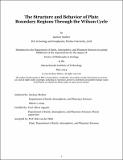The Structure and Behavior of Plate Boundary Regions Through the Wilson Cycle
Author(s)
Molitor, Zachary
DownloadThesis PDF (23.63Mb)
Advisor
Jagoutz, Oliver
Terms of use
Metadata
Show full item recordAbstract
This thesis explores the geochemical and geophysical properties of plate boundary regions in the Atlantic, East Africa, the New England Appalachians, and subduction zones around the Pacific Ocean. Chapter One presents geochemical constraints on the extent of enriched mantle from upwelling mantle plumes relative to the observed extent of topographic swells related to mantle flow. It builds on this data by presenting a new geophysical model of mantle flow around mantle plumes that constrains the viscosity structure of the upper mantle and emphasizes the role of dynamic pressure from flowing mantle in the generation and maintenance of plume swell topography. Chapter 2 presents new experimental constraints on subduction zone melts at 2.4 GPa and temperatures representative of conditions near the top of the subduction slab in the mantle wedge. Our experimental constraints support existing hypotheses that proposed erupted primitive high magnesian andesites are produced through mantle melting and mixing of melts in the mantle wedge, while also presenting novel constraints on the concentration of water that can be maintained in glass during quenching. Chapter 3 presents a field-based study of low melt fraction migmatites in central New Hampshire. In it, we utilize a unique approach, based on the compaction lengthscale, to calculate the shear viscosity of the migmatite during deformation associated with the Acadian-Neoacadian orogeny and the presence of an orogenic plateau. Chapter 4 presents a detailed macro- and microscale analysis of structures and deformation in southern New England related to contemporaneous strike-slip conjugate faulting in the upper crust. In it we present new electron backscatter diffraction (EBSD) data and in situ trace element and U-Pb isotopic compositions for monazite and titanite. These datasets provide quantitative constraints on the style and conditions of deformation in the weak middle crust beneath an orogenic strike-slip conjugate shear system (in the upper crust). Furthermore, this data constrains the late Paleozoic stress field in New England and the kinematics of collision between Gondwana and Laurasia.
Date issued
2024-05Department
Massachusetts Institute of Technology. Department of Earth, Atmospheric, and Planetary SciencesPublisher
Massachusetts Institute of Technology